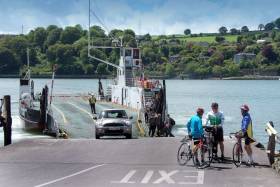Displaying items by tag: Cross River Ferries
Cross River Ferries which operates a major short-cut across Passage West in the centre of Cork Harbour, this year celebrates three decades of the river Lee service, writes Jehan Ashmore.
Since March, 1993 twin vehicle-ferries have operated the Glenbrook (Passage West Pier)-Garrigaloe (Rushbrooke Pier) route which links both sides of Passage West, a narrow stretch along the river Lee.
At this stretch is the nearby town of Passage West (approx. 10kms south-east of Cork City) and on the east bank is Great Island where at Cobh seasonal cruise ships frequently call.
The convenient short-river crossing on average takes just five minutes and is served by the either of the twin car-ferries, Glenbrook and Carrigaloe. They ply on the non-stop crossings which run between 6:30am – 9:30pm daily.
Whether its busy commuter traffic or weekend use, Cork River Ferries caters for customers in cars, vans, trucks, mini-buses, motorbikes and cyclists.
In addition to taking foot passengers where the ferry provides great opportunities for low angle photography of ships heading to and from Cork city quays.
Also transported on the ferries are trucks exceeding 9m and arctic trucks which can use the double-ended ferries with each taking 27 vehicles and 200 deck passengers.
The service operated by Cross River Ferries, is part of the Doyle Shipping Group (DSG) which has extensive maritime operations throughout the island of Ireland which includes ports, logistics and renewables.
As for the pioneering car ferry service on the Lee, this was the vision of the late Bryan J Foley, the former Managing Director of Marine Transport Service (MTS) based in Cobh.
Thus the creation of the Cross River Ferries provided an alternative option to avoid Cork City when travelling in either direction, east and west of the Munster city.
In addition the ferry short-cut across Passage West was opened six years before the Jack Lynch toll-free Tunnel was opened. The first vehicles to make use of the under-river tunnel took place in May, 1999.
Sailings are based on a single ferry operating while the second ferry is on standby in case of emergency or routine maintenance. When a ferry is not in use, they take up a river berth at Cork Dockyard (also part of DSG) which handles the vessel's annual dry-dockings.
When Cross River Ferries was founded, this involved a joint venture between Marine Transport Services (owned by DSG) and Arklow Shipping Ltd. The Co. Wicklow shipowner’s stake however was bought out by DSG in 2007.
Former 'Skye' ferries
By that stage the ferries had served the link for more than decade, having originally seen service in Scotland on the Isle of Skye route of Kyle of Lochalsh-Kyleakin. The latter location is on the Isle, made famous by the Scottish folk song 'Over the Sea to Skye' also known as the "Skye Boat Song".
The twin ferries then named Lochalsh (Glenbrook) and Kyleakin (Carrigaloe) were purpose built in the early 1970's at the Newport Shipbuilding & Engineering Co. in Gwent, south Wales to serve Caledonian Steam Packet Co. The operator would later become Caledonian MacBrayne otherwise commonly known with the branding of Calmac.
With completion of the first fixed link to Skye of a road bridge at Kyle of Lochalsh on the mainland, this led to the ferries becoming redundant. The ferries, each of 225 gross tonnage, were sold to Cross River Ferries with the inaugural sailing starting in the Spring of three decades ago.
Despite the end of these ferries in Scotland, the option to travel by sea to this west coast Isle remains as CalMac continues to operate but out of Mallaig on the mainland to Armadale.
Crossings can vary between 23 and 45 minutes, subject to season and ferries deployed.
#ferries - Owners of the River Lee car ferry service in Cork harbour, the Irish Examiner reports, have told Cork County Council they don't believe it's economically viable to put on a second ferry at peak evening times.
Doyle Shipping Group (also operators of Cross River Ferries) contacted Paraic Lynch, municipal officer for the Cobh/Glanmire Municipal District Council, to tell him the news after a number of councillors petitioned the company to beef up their service from Glenbrook, on the Passage West side to Carrigaloe, on the Cobh side.
Councillors living in the Cobh area are particularly concerned about the length of time it is taking people to get across the harbour from the Glenbrook side during the evening rush-hour period.
Mr Lynch told the councillors that Doyle Shipping had contacted him to say they didn't see it as viable to operate two ferries at that time. However, he added that the company says it will continue to monitor the situation, especially when major work gets underway on the €100m upgrade of the Jack Lynch Tunnel/Dunkettle interchange later this year.
Councillors are particularly concerned about that as they believe it will drive more motorists to use the cross-river ferry to avoid delays at the northern side of the tunnel as the upgrade works get underway.
For further comments by councillors following the decision announced by the shipping group click here.




























































